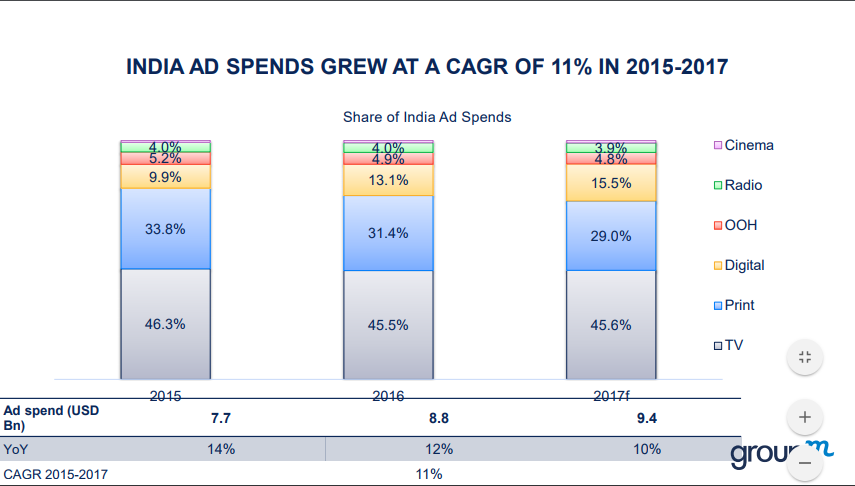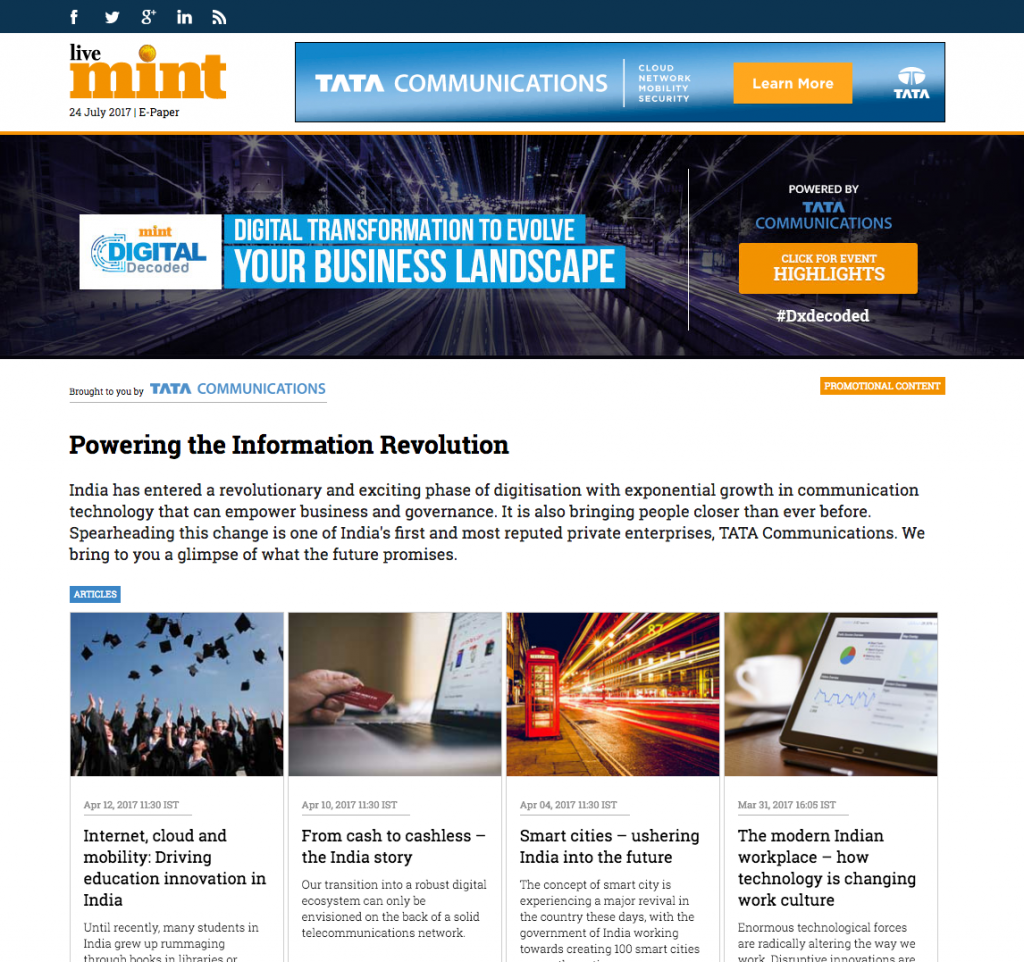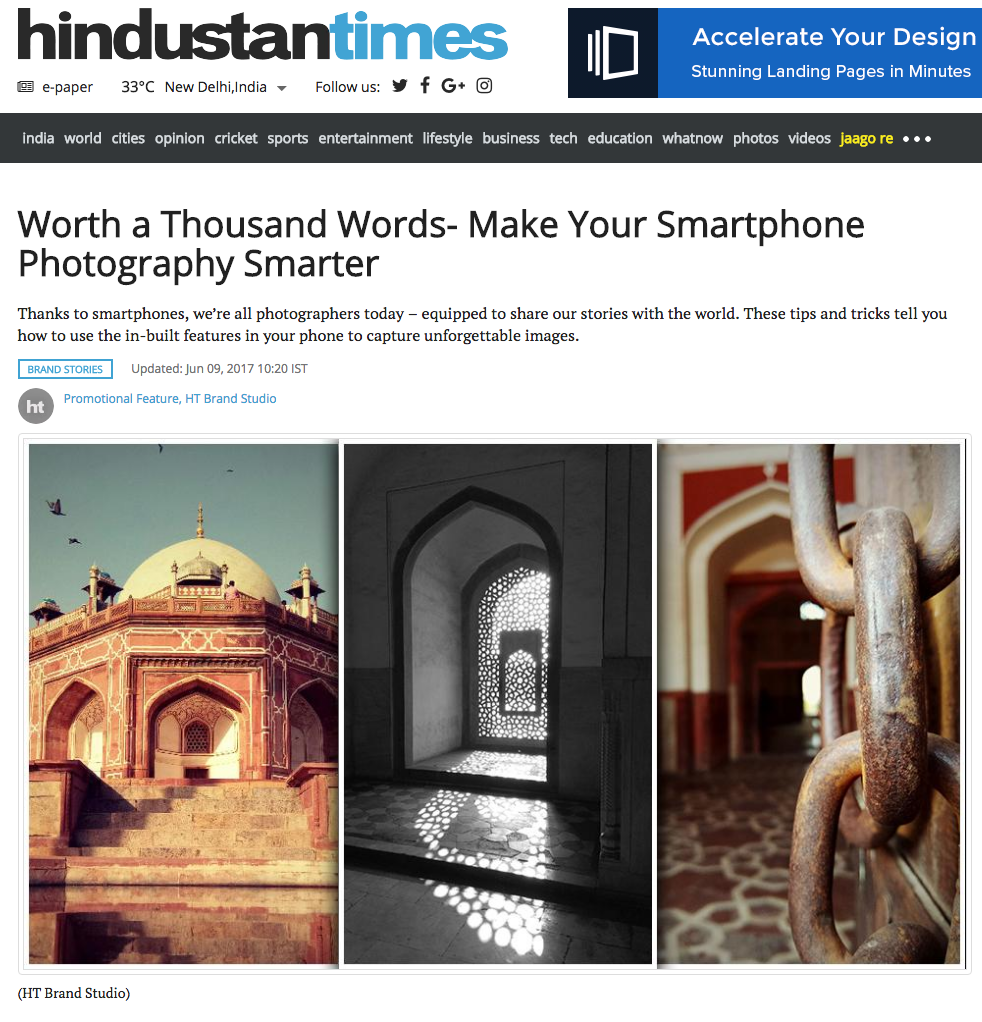This article is part of a series of interviews that NAI has conducted with the directors of publishers’ Native Ad Studios around the world.
HT Media was founded in 1924 when its flagship newspaper, Hindustan Times was inaugurated by Mahatma Gandhi. Hindustan Times is an Indian English-language daily newspaper with a circulation of about 1.1 million copies. It is the second most widely read English newspaper in India. HT Media (BSE, NSE) has today grown to become one of India’s largest media companies.
We recently spoke with Kaveri Jain, Head of HT Brand Studio and Digital Marketing Lead, a studio part of HT Media Group. Here's what he had to say:
India is still a nascent market for native/branded content
Jain: I often use the terms "branded" and "native" interchangeably. But it is expanding rapidly and if the appropriate market conditions are permitted to thrive, it has the potential to become a leading digital format. In the last two years, I have personally witnessed considerable growth in digital investments on native. And I am curious to see how agencies, publishers, and marketers shape the emerging landscape.
The introduction of branded content seems like a no-brainer at so many levels.
There have been numerous debates on ad blockers, diminishing attention spans, obscene volumes of content online, social media fatigue and the inability to differentiate between real and fake. However, none of this has negatively impacted online traffic or content consumption. In fact, they continue to show an upward trend. In India, with smartphone proliferation, the trend is even more marked. This is why the introduction of branded content seems like a no-brainer at so many levels.

→ RELATED ARTICLE:
Native Advertising in the Philippines: the Process of a Local Publisher
The challenges and opportunities for native advertising in India
Jain: The biggest opportunity I see is in the scale that branded content offers to marketers for building long term engagement online. The immediate challenge is that of imagination -- to conceive just how big this can become. Most marketers and agencies haven’t fully grasped the shift that is taking place and hence still treat native as a substitute to display advertising -- which it is not.
We end up spending sizeable time educating our partners on why we must go beyond advertorials and brand heavy stories towards smart native content. But to fully do justice to native, we need to break away from the deadline gridlock, limited investment and the unreasonable expectations of quick delivery.
→ RELATED ARTICLE:
Native Advertising in Russia: How One Media Company Became the Leader
Then there is the ROI conundrum.
Jain: Digital advertising has always had an immediate and high ROI expectation. But native content must be evaluated beyond that. Not only does it have a longer shelf life, it is rich content that resides outside brand platforms devoid of obvious advertising messages. The question therefore that brands need to ask is: how can we build on that, consistently and qualitatively?
There is also merit in moving away from chasing publisher novelty and traffic to actually reaching your audiences. It’s not the volume; it’s who your content eventually speaks to.We are also still fighting the tag war; paid vs editorial. But people read good content. Paid or not. And that’s a fact established by a number of case studies.
How HT Brand Studio produces native advertising
Jain: HT Brand Studio is an independent team, set up specifically to create native content. The editorial team plays no role in creating branded content and it was a conscious decision to keep the two separate.
HT Brand Studio is currently an eight-member team and we’re looking to expand quickly. We’re a collective of journalists, creative writers, brand and digital marketers, video producers, animators and graphic designers. But along with the in-house team, we also have a panel of domain experts who work on a project-to-project basis. Outsourcing gives us the flexibility to address a wide range of briefs and novelty to content.
The team is an eclectic mix and each member brings something unique to the creative process. We were conscious of this while hiring and sought out curious and engaged minds, each of whom is a storyteller in their own right and in their own way.
We ask all candidates to submit two to three case studies as part of the interview process. The objective is to assess whether the candidate can think innovatively and outside his/her comfort zone. It has however been hard to recruit for the studio. Finding people with a blend of managerial and client servicing skills, ability to work with product owners while ensuring seamless execution is a tough ask.
But over time the team has worked well together and developed many soft skills needed for the job.Our creative portfolio includes; stories, animated and live action videos, infographics, comic strips & illustrations, photo essays, webinars, podcasts, microsites & branded pages – basically anything that is web compatible. The team today is well equipped to handle this.
→ RELATED ARTICLE:
6 Best Practices for Native advertising and content marketing Success
How creative ideas come to life at HT Brand Studio
Jain: I think it is hard to define THE creative process because there isn’t one. We work like a start-up within a set-up and that has worked well for us. Almost everyone multitasks (skills permitting) and ideation is a shared process. Also once a brief comes in, there is significant due-diligence done before we start ideating to avoid duplication. It’s ideal to be in the know of all recent brand campaigns and communication related to the brief.
I think both marketers and agencies need to appreciate that great ideas take time.
There have been times when a brilliant idea came to someone post-work hours. And yet many eureka moments have occurred during brainstorming sessions. But ideas often evolve and undergo alterations till the execution stage. We maintain that flexibility to ensure that the final piece of content is near perfection and not lacking in a brand or campaign affinity, which is essential. However, it becomes a challenge when the time available is not optimum. I think both marketers and agencies need to appreciate that great ideas take time.
We have no written guidelines [for HT Brand Studio] as such and in any case, they evolve case by case. Being rigid won’t serve our purpose since each brief is unique and has atypical requirements.
We maintain a very clear distinction between editorial and branded content; a rule that is sacrosanct. Native content is tagged as Promotional or Sponsored Content without exception. And the same rule applies to all placeholders across our sites, contextual placements, and social media handles.
Editorial still perceives native as advertorials. I hope that in time that perception will change.
We haven't received any complaints internally from the editorial or from readers regarding branded content. We are invested in our content and ensure that such situations do not arise. We’ve realised that readers appreciate good content and as long as editorial is assured that no native content goes untagged, there is no point of contention. However, editorial still perceives native as advertorials, which it is not, and I hope that in time that perception will change.
Clients and KPIs
Jain: In most cases, we don't turn clients down. But we have pushed back anything that is inappropriate, unethical or can backfire. Some are obvious cases where publisher guidelines don’t permit that content. But there have been instances when agencies/brands have suggested content ideas that enter certain grey areas. The team has sufficient marketing and journalistic experience to guide partners on what works and what doesn’t and we also play the role of educating them in this regard. And on the whole, we’ve found partners to be fairly receptive.
We have set some standard reporting templates for short length campaigns. Digital reach and/or social engagement are typically what marketers seek.
However, long-term projects may have additional KPIs which are aligned with us at the start. Generally, these are defined by campaign objectives and goals which also impact the content strategy.
Agencies that are content partners to clients play a larger role in developing the strategy meaning content and amplification with us. But over time media buying agencies have started to act as agents for selecting publishers, such as us. After which we continue to engage with marketers directly and develop the campaign strategy with them.
We also have several projects initiated directly by marketers via our in-house sales teams and these have proven to be far more time-effective and led to long-term relationships.
We are quite proud of the positive response from all our clients and most of them have returned with larger projects, both directly and through agencies.
Avoid falling into the trap of creating a large/self-sustained studio in-house.
5 Learnings when setting up a Native Ad Studio
Jain:I reckon that most of my learnings are covered in the answers above. But to summarise I would say:
- The team should be highly cohesive because the nature of work requires that everyone works well together.
- Treat your readers with respect. The reader has become smarter than before and that should be the key consideration while creating branded content.
- Hire young people and from diverse backgrounds (especially for creative roles). I can’t emphasise that enough. Their appetite for information and ability to think beyond the obvious is what a studio needs. And as digital natives, they understand the medium better.
- Avoid falling into the trap of creating a large/self-sustained studio in-house. Outsourcing offers numerous benefits – freshness, domain expertise and scale for instance.
- Don’t block or kill creativity by getting bogged down with the volume of briefs or partner expectations. There will come a time when you may have to turn someone down to ensure that quantity doesn’t take precedence over quality.
 By
By 






